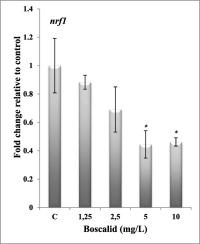Comparative Biochemistry and Physiology C: Toxicology & Pharmacology ( IF 3.9 ) Pub Date : 2020-06-11 , DOI: 10.1016/j.cbpc.2020.108830 Feyza Icoglu Aksakal 1

|
Boscalid is a succinate dehydrogenase inhibitor fungicide commonly used to control a range of plant pathogens. Although it is one of the most common fungicides in the aquatic environment, the potential adverse effects of boscalid on freshwater invertebrates still remain unclear. This study aimed to evaluate the toxicity of boscalid on Daphnia magna (D. magna) and provide new information to assess the eco-toxicity of the boscalid on aquatic invertebrates. The effects of boscalid on malondialdehyde (MDA) level, activities of antioxidant enzymes such as superoxide dismutase (SOD), catalase (CAT) and glutathione S-transferase (GST) and the mRNA level of genes associated with antioxidant system (sod, cat, and gst) and detoxification (cytochrome P450 4 (cyp4) and nuclear respiratory factor 1 (nrf1)) were determined after 48 h treatment. The effect of boscalid on reproduction and development of D. magna was evaluated by a 21-d-chronic toxicity test. Boscalid dose-dependently altered activities of SOD, CAT, and GST and led to lipid peroxidation during acute exposure in D. magna. Exposure to 5 and 10 mg/L boscalid also significantly decreased gene expression of sod, gst, cyp4 and nrf1 but increased cat gene expression. Furthermore, chronic toxicity results showed that exposure to boscalid decreased molting frequency, number of neonates per Daphnia, and the number of broods per female as compared to the control groups. The above results indicated that boscalid had significant negative impacts on D. magna, and information present here helps to evaluate the eco-toxicity caused by boscalid on aquatic invertebrates.
中文翻译:

通过使用抗氧化酶活性,抗氧化和解毒系统相关基因的表达以及生活史参数来评估水蚤对大型蚤的毒性。
Boscalid是一种琥珀酸脱氢酶抑制剂杀菌剂,通常用于控制一系列植物病原体。尽管它是水生环境中最常见的杀真菌剂之一,但仍不清楚Boscalid对淡水无脊椎动物的潜在不利影响。这项研究旨在评估Boscalid对Daphnia magna(D . magna)的毒性,并提供新的信息来评估Boscalid对水生无脊椎动物的生态毒性。硼硅酸对丙二醛(MDA)水平,抗氧化酶活性(如超氧化物歧化酶(SOD),过氧化氢酶(CAT)和谷胱甘肽S-转移酶(GST))的影响以及与抗氧化系统相关的基因的mRNA水平(草皮,猫,和GST)和解毒(细胞色素P450 4(CYP4)和核呼吸因子1(NRF1))的48小时处理后确定的。啶酰菌胺的对生殖和发育的影响d。通过21天慢性毒性试验评估了玛格纳。Boscalid剂量依赖性地改变了D急性暴露过程中SOD,CAT和GST的活性,并导致脂质过氧化。麦格纳。暴露于5和10 mg / L的Boscalid也会显着降低sod,gst,cyp4和nrf1的基因表达,但增加cat基因表达。此外,慢性毒性结果显示,与对照组相比,暴露于Boscalid会降低蜕皮频率,每水蚤的新生儿数量和每位女性的育雏数量。由以上结果可知,Boscalid对D具有显着的负面影响。magna,这里提供的信息有助于评估由Boscalid引起的对水生无脊椎动物的生态毒性。


























 京公网安备 11010802027423号
京公网安备 11010802027423号